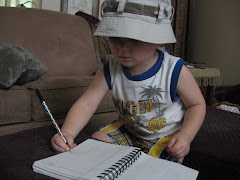Myers, W. D. (2011). We are America Ill.
C. Myers. New York , NY
"We Are America is one way I have of
answering [my grandparents’] questions, my dreams of what this rich country is,
was, and will continue to be . . . . in some way the beauty of this country is
its open-endedness, the question mark of it.
Where other places in the world end in periods, neat packets of sealed
identities, we end in possibilities. "
Thus begins the book We
Are America: A Tribute from the Heart in the “Artist’s Note” on the front
pages of the book.
Walter Dean Myers and his son Christopher have crafted a
book of poetry and illustrations that reflects the story of America – its
bright hope for freedom, and a place where some dreams are realized while some
are not. In his “Author’s Note,” Walter
Dean Myers states that after 9/11, his thoughts went to how he had taken his
liberties and opportunities for granted.
“It was no longer enough just to exercise my right to criticize both our
history and our present state. I needed
to take responsibility for that history, our present, and our future.” The poems in this volume are his tribute to America .
This is a wonderful book of poetry by an African American
author who is already well known by so many young adult readers. Walter Dean Myers is perhaps most often known
for his gritty young adult novels such as Monster
and Slam. But this volume of poetry, with illustrations
by his son Christopher, is a beautiful book that reflects the history of America and the
dreams that so many have had before and/or after coming to this country. Africans and Native Americans are given voice
in some of the poems as are immigrants who came to this land looking for the
opportunities they had heard were abundant, and looking for a fulfillment of
dreams that often were not realized. However,
all poems are respectful in their portrayal of America ’s strengths and
shortcomings.
Myers’s poems are summarized in this poem found near the end
of the book:
We are America
The land of
the free
Wealthy beyond
belief
and
not wealthy
The land of
equal opportunity
and
not equal
The land of
justice
and
injustice
Social Studies teachers from middle grades through high
school could use the simple yet eloquent poems penned by the elder Myers in
this book to explore how America
has been seen as the land of opportunity, and how those dreams have come true
for some, and not for others. The
diversity of the people who have called America home is beautifully illustrated
in the younger Myers’s rich, colorful paintings that span America’s history
from “Before there was America” to the present sky scrapers of our modern
cities.
Other features of this book of poetry include quotations
from sources such as the Constitution of the United
States and the Declaration of Independence as well as historical
figures from King Ferdinand and Queen Isabella of Spain to Barbara Jordan at the
Democratic National Convention in 1976.
Those quotes are elaborated upon at the end of the book. “Art Notes” explain the illustrations and
name the famous figures included in them such as Amelia Earhart, the John
Hancock Building, and Greg Louganis. The
only criticism I have of the book would be that the “Art Notes” reference page
numbers, but the pages aren’t actually
numbered. So matching up the
notes to the correct pages is a little frustrating.
This book would be an excellent addition to any Social
Studies class and is a great resource for taking a look at the history of America . The poems would be a wonderful jumping-off
place for looking at “The American Dream” and how it has been realized or
fallen short. Most students, especially
minority students, will find themselves in these poems and the art that accompanies
them. This volume was not in my personal
collection until I found it in my public library; however, Amazon has one on
the way to me as I type. I’m anxious to
add it to my classroom library where my high school English students will have
access to it, and where I can use it for writing prompts that are meaningful,
personal, and relevant.



No comments:
Post a Comment